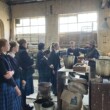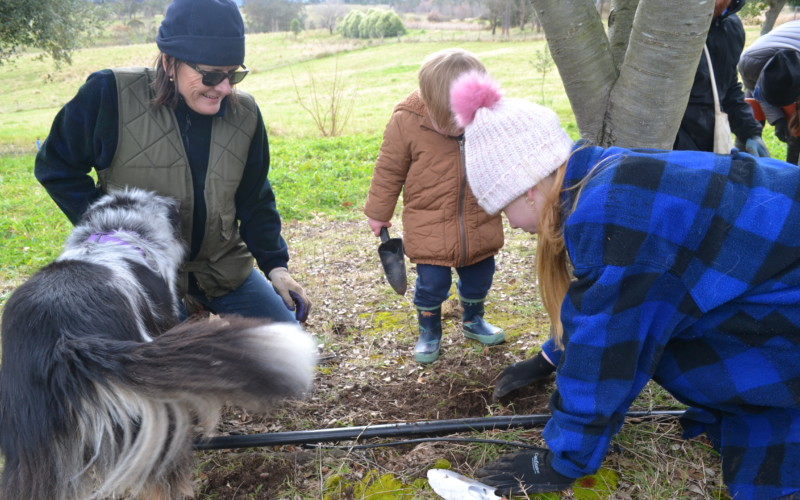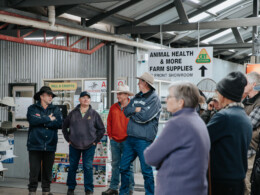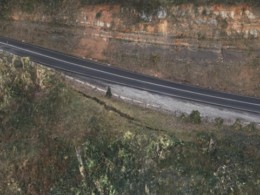What better way to spend Bastille Day than getting down in the dirt on a truffle hunt. This is what actually happened to me at our local truffiere, Hartley Truffles, with the Austen family and their dogs Coco and Maggie.
Richard and Jane Austen of Hartley Truffles have been joined by their daughter Jessica, son-in-law Wayne and their three adorable grandchildren who are rapidly learning the art of truffle farming in the height of the season.
So it was on this cold, crisp morning with the sun barely showing through the clouds that we followed the dog’s lead into the orchard in search of the elusive ‘subterraneous ascomycete fungi’ – truffle sounds so much more romantic!Grandchildren shrieking with delight, trowel in hand, learning how to dig up the precious morsels, dogs scratching the surface of the soil and waiting intensely for their reward, bags for good truffles, bags for rejects… Never a dull moment on a family truffle hunt!
Jane and Richard are always both excited and exhausted during the truffle season. “We are so proud and driven to share our truffles with Australia and want people to experience the aroma and flavour of this magical fungus,” Jane said.
“Truffles are no longer reserved only for the wealthy. They are a worthwhile culinary investment and a pleasurable experience. Why use truffle oil which is packed full of chemicals when you can use the real thing in season? Such a wonderful seasonal experience should not be missed”, Jane added.
Jane continued, “If you can’t use all of your truffle after you have bought it, then you can store it for a while as truffle butter, add it to honey or infuse oil, but be sure to use the oil within a few days. “
The truffle industry in Australia has suffered under these strange weather conditions, just like other crops have across the country. In addition to the lack of frosts which ripen the truffle, the wet conditions have forced the cunning fungi to grow in a different direction. Truffles are very adaptable and during the wet conditions they have altered their growth trajectory from a generally downwards motion a wider shape, much closer to the surface.
Whilst the truffle farmers are happy to get any truffles at all after these exceptional weather patterns, there are problems to how the truffles are now growing. Richard explained, “When the truffle grows near the surface it can be easily damaged or fail to ripen. When this happens, we put them into our value added products or we blend them into a ‘soup’ or ‘slurry’ and put back into the soil to reinnoculate the trees.” One bonus with the recent wet climate is that the Austins have not had to irrigate their trees for 2 seasons now, due to the high rainfall.
The truffle growers of NSW and ACT are a very coordinated community. Five years ago, a number of them created the EAT Truffle Cooperative whereby members follow agreed production practices similar to those adopted in Europe whence the truffle originates. Members of the EAT Truffle Cooperative enjoy a climate that closely matches the truffle product areas of Europe and grow the famous Perigord truffle, otherwise known as Tuber meanosporum.
From the customer’s perspective, when they buy through from a member of the cooperative they can be guaranteed:
– Aproductwithsuperiorflavourandaroma – Astringentlyclassifiedproduct
– Fastdelivery,and
– Afairprice
Some unscrupulous truffle producers can flood the early season market with unripe product for a lower price which not only disappoints the customer, but also sets a false market price for the industry for that season. This is why buying from a co-op likeEAT Truffles is great for the customer as they always know the standard is going to be high and consistent.
There are now 23 members of the EAT Truffle cooperative from Niangala in the north down to as far south as Bredbo, and all points between following the Great Dividing Range.
One fairly new member of EAT Truffle has an up-and-coming truffiere in Wallerawang. Philip and Megan Gely planted 650 trees which are in their 7th year and 700 trees which are in their 2nd year and are hoping to join the big production ranks any year now.
Philip said, “It’s so helpful to be part of such an innovative co-operative. There is so much spark and passion among the members – it is a godsend as newcomers to be part of such a family.”
The co-op members ‘hunt to order’ and send their truffles to their headquarters in Sydney where they are sold to restaurants, delis, markets and also to online customers. Members of the cooperative ‘cluster’ in the Central West meet up to pool their harvest and whoever has volunteered to do so, takes the precious bounty to Sydney for sale. Without this level of camaraderie and cooperation these truffieres would find it much harder to function.
Richard Austen explained, “We want our customers to have the best possible experience, and of course, we want our Eastern Australian Tablelands Truffles to be known. Appropriately, this abbreviated nicely to an EAT Truffle acronym. What we also discovered was the capacity to create a genuinely international standard truffle.”
Sales so far this year have been strong with a slight increase in online sales. The cooperative sells to domestic (as far north as Port Douglas), commercial and international customers. In fact, a distributor in Spain will shortly receive a trial shipment of EAT Truffles which will hopefully lead to an ongoing export business.
You can find Jane and Richard of Hartley Truffles (hartleytruffles.com.au) at Blackheath Markets during the season and also in Sydney at the Carriageworks Markets. You can contact the EAT Truffle cooperative for more information ateattruffle.com.au. Fresh black truffles are available to order online, over the phone or in person. As with any product, price is dependent upon the grade selected and volume to be supplied. To enquire about our three grades of truffles and prices, please call 0497 783 053.









